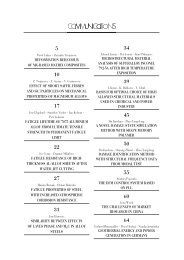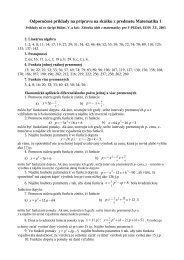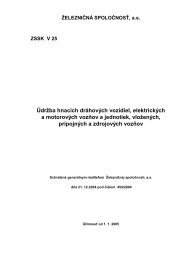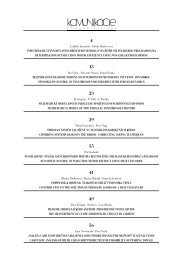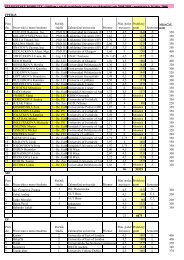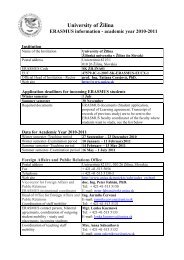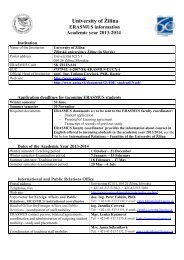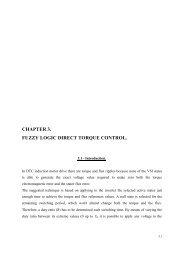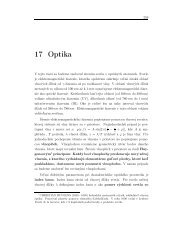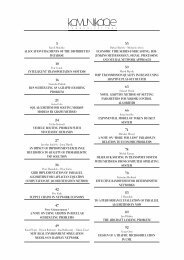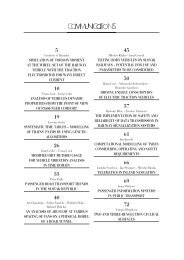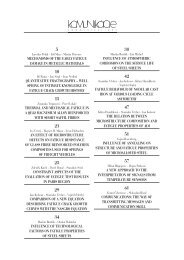posudzovanie vplyvu automobilovej dopravy na ... - Žilinská univerzita
posudzovanie vplyvu automobilovej dopravy na ... - Žilinská univerzita
posudzovanie vplyvu automobilovej dopravy na ... - Žilinská univerzita
You also want an ePaper? Increase the reach of your titles
YUMPU automatically turns print PDFs into web optimized ePapers that Google loves.
C O M M U N I C A T I O N S<br />
I S<br />
matic hydrocarbons by weight (the lowest content), and the highest<br />
for fuel “3” containing 17.68% of aromatic hydrocarbons by weight<br />
(the highest content).<br />
5. Conclusions<br />
It has been found that, as a result of fuel post-injection in the<br />
engine cylinder, nitrogen oxides are reduced not only in the catalytic<br />
converter, but also in the exhaust manifold between the<br />
cylinder and the converter. Two methods of NOx reductions were<br />
isolated: the SNR process (Selective Non-Catalytic Reduction)<br />
taking place outside the converter, and the SCR process (Selective<br />
Catalytic Reduction) in the catalytic converter. To evaluate<br />
the effects of NOx reductions, several definitions of various NO x<br />
reduction efficiency measures have been introduced. The main<br />
conclusions drawn from the experiments are as follows:<br />
1. The results indicate that the total efficiency of the NO x reduction<br />
depended mainly on the efficiency of Selective Non-Catalytic<br />
Reduction (SNR). The additio<strong>na</strong>l fuel dose volume,<br />
engine speed and engine load were influential factors. Better<br />
effects were observed at lower engine speeds.<br />
2. The influence of the fuel post-injection angle on the NO x<br />
reduction efficiency was the strongest when the additio<strong>na</strong>l fuel<br />
dose was injected close to the TDC. In such a case better<br />
effects were obtained from the SNR process, but with a negative<br />
effect in the converter. As a result, the total effect of the<br />
reduction practically did not depend on the fuel post-injection<br />
angle. Injection of the additio<strong>na</strong>l portion of fuel too close to<br />
the TDC is, however, not allowed because of the possible autoignition<br />
of diesel fuel. This would lead to a rapid increase in<br />
the exhaust gas temperature and possible damage to the converter.<br />
In view of the above, and considering also an effective<br />
use of the reducing agent (which has an effect on diesel fuel<br />
consumption), it would be more advantageous to inject the<br />
additio<strong>na</strong>l fuel dose at crank angles between 120 and 160 °<br />
ATDC. These values do not have to be the optimum values for<br />
different operating conditions of the engine (engine load and<br />
engine speed), and for other engines.<br />
3. The tests conducted at two different engine speeds and constant<br />
engine load showed that the influence of the additio<strong>na</strong>l<br />
fuel dose volume, and the HC 1 /NO x ratio before the converter,<br />
on the efficiency of NO x reduction in the catalytic converter<br />
SCR is rather small. This influence could be, however, more<br />
visible in different operating conditions of the test engine. The<br />
resultts obtained from the study justify the conclusion that<br />
there is a need for further research into a catalytic system which<br />
would feature higher activity and better selectivity, and could<br />
be used in the converter. Some parameters, such as the reaction<br />
time, may be also optimized by adjusting the volume of<br />
the converter to the volume and rate of flow.<br />
4. A strong influence of the space velocity of exhaust gas flowing<br />
through the converter on the efficiency of selective catalytic<br />
reduction of nitrogen oxides taking place inside the converter<br />
was found. By reducing this velocity, the efficiency of NOx<br />
catalytic reduction was raised.<br />
5. In order to optimize the efficiency of NO x reduction, the temperature<br />
of exhaust gas before the converter should be maintained<br />
in a strictly defined range.<br />
6. The influence of fuel composition on the efficiency of selective<br />
non-catalytic reduction of nitrogen oxides turned out to be<br />
rather low. However, a stronger influence of fuel type on the<br />
efficiency of catalytic reduction taking place in the converter<br />
was observed. It was determined that fuels containing more<br />
aromatic hydrocarbons provide better opportunities in terms<br />
of the effectiveness of selective catalytic reduction of nitrogen<br />
oxides.<br />
References<br />
[1] BOEHMAN A. L.: Numerical Modeling of NO Reduction Over Cu-ZSM-5 Under Lean Conditions. SAE Transactions 1997, nr 930735,<br />
pp. 11-17.<br />
[2] CENTI G., GALLI A.: Mono and Polynuclear Cu Species in ZSM-5. Nature and Reactivity in the Reduction of NO in the Presence of<br />
Various Reductants. 12 th Inter<strong>na</strong>tio<strong>na</strong>l Zeolite Conference. 1999 Materials Research Society, s. 1359-1366.<br />
[3] CISEK J., SZLACHTA Z., WCISŁO G.: Ograniczenie emisji tlenków azotu w spali<strong>na</strong>ch silnika wysokoprężnego przez zmniejszenie<br />
ich powstawania w komorze spalania. Problemy Eksploatacji, 1999, nr 3, s. 9-21.<br />
[4] CISEK J., SZLACHTA Z., WCISŁO G.: Ograniczenie emisji tlenków azotu w spali<strong>na</strong>ch silnika wysokoprężnego za pomocą konwertorów<br />
katalitycznych. Problemy Eksploatacji, 1999, nr 3, s. 23-33.<br />
[5] DARKOWSKI A., KRUCZYŃSKI S.: Badania <strong>na</strong>d katalityczną redukcją NO x w spali<strong>na</strong>ch silników o zapłonie samoczynnym. Chemia<br />
i Inżynieria Ekologicz<strong>na</strong>, nr 5-6, 1998, s. 397-403.<br />
[6] ENGLER B.H., LEYRER J., LOX E. S., OSTGATHE K.: Catalytic Reduction of NO x with Hydrocarbons Under Lean Diesel Exhaust<br />
Gas Conditions. SAE Transactions, 1993, nr 930735, s. 535-561.<br />
[7] DARKOWSKI A., KRUCZYŃSKI S.: Badania selektywnej katalitycznej redukcji tlenków azotu <strong>na</strong> katalizatorach opartych o metale<br />
szlachetne. KONES’98, s. 92-97.<br />
[8] HAMADA H.: Selective reduction of NO by hydrocarbons and oxyge<strong>na</strong>ted hydrocarbons over metal oxide catalysts. Catal. Today, 1994,<br />
22, 21.<br />
[9] HAVENITH C., VERBEEK R. P., HEATON D. M., SLOTEN P.: Development of a Urea DeNO x Catalyst Concept for European Ultra-<br />
Low Emission Heavy-Duty Diesel Engines. SAE Transactions, 1995, nr 952652, s. 675-684.<br />
34 ● KOMUNIKÁCIE / COMMUNICATIONS 1/2003



